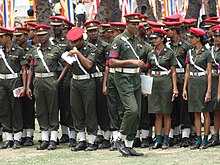History
With the establishment of the Ceylon Army in October 1948, a Provost Section was raised. The section then consisted of 1 officer and 16 NCOs. On 1 October 1951 the establishment was increased to that of a company, and Capt E.R.P De Zilwa was appointed officer commanding. In 1959 the company was elevated to the level of the unit, and the commanding officer was promoted lieutenant colonel.
With the rapid expansion of the army in recent years, the corps has also been gradually increased and has provost sections at every army detachment.
In 1979 the military police had the rare honour of performing the ceremonial guard duties, such as Guard Mounting at the President’s House and to meet this requirement, the President’s Ceremonial Guard Company was formed.
Specialized branches such as the Special Investigations Branch and the Traffic School were included to the establishment by the provost in order to counter various crimes and also misconduct and infringement of road rules on public highways by army personnel. The Special Investigations Branch has now expanded to a Special Investigation Unit, directly functioning under the Directorate of Provost Marshal.
The introduction of the Sri Lanka Army Women’s Corps gave necessity to maintain the discipline of the women soldiers, and the Provost Section of MP Women was established in 1983.

Military police (MP) are law enforcement agencies connected with, or part of, the military of a state. In wartime operations, the military police may support the main fighting force with force protection, convoy security, screening, rear reconnaissance, logistic traffic management, counterinsurgency, and detainee handling.
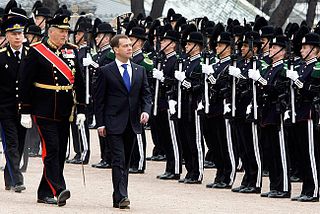
In some militaries, foot guards are senior infantry regiments. Foot guards are commonly responsible for guarding royal families or other state leaders, and they also often perform ceremonial duties accordingly, but at the same time are combat soldiers.

The Royal Military Police (RMP) is the corps of the British Army responsible for the policing of army service personnel, and for providing a military police presence both in the UK and while service personnel are deployed overseas on operations and exercises. Members of the RMP are often known as 'Redcaps' because of the scarlet covers on their peaked caps and scarlet coloured berets.

The Canadian Forces Military Police provide police, security and operational support services to the Canadian Armed Forces (CAF) and the Department of National Defence (DND) worldwide.

The Royal Marines Police, or Royal Marines Police Troop is the Royal Marines element of the Royal Navy Police and the military police arm of the Royal Marines.

The SAF Military Police Command is the military police formation of the Singapore Armed Forces (SAF). Established as the Singapore Armed Forces Provost Unit (SAFPU) in 1966, its primary role is to police duties to uphold standards of discipline within the SAF, and to provide security coverage for key SAF military installations and the Ministry of Defence (MINDEF) headquarters at Bukit Gombak.
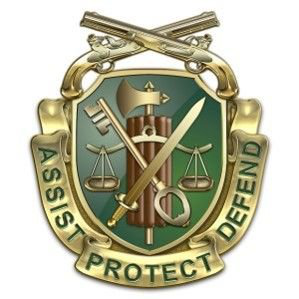
The United States Army Military Police Corps (USAMPC) is the uniformed law enforcement branch of the United States Army. Investigations are conducted by Military Police Investigators under the Provost Marshal General's Office or Special Agents of the Department of the Army Criminal Investigation Division (CID).
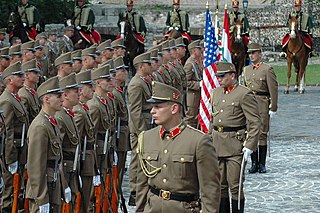
A guard of honour (GB), also honor guard (US), also ceremonial guard, is a group of people, usually military in nature, appointed to receive or guard a head of state or other dignitaries, the fallen in war, or to attend at state ceremonials, especially funerals. In military weddings, especially those of commissioned officers, a guard, composed usually of service members of the same branch, form the sabre arch. In principle, any military unit could act as a guard of honour. However, in some countries certain units are specially designated to serve as a guard of honour, as well as other public duties. Republican Guards, Royal Guards and foot guards frequently have ceremonial duties assigned to them.

The Kor Polis Tentera DiRaja is the military police branch of the Malaysian Army. Referred to as the "Redcaps" like their British counterpart or, more popularly, known as "MPs", the Kor Polis Tentera DiRaja keep discipline within the Army ranks and ensure security at Malaysian Army installations.

The National Gendarmerie is one of two national law enforcement forces of France, along with the National Police. The Gendarmerie is a branch of the French Armed Forces placed under the jurisdiction of the Ministry of the Interior, with additional duties from the Ministry of Armed Forces. Its responsibilities include policing smaller towns, suburbs and rural areas, along with special subdivisions like the GSPR. By contrast, the National Police is a civilian law enforcement agency that is in charge of policing cities and larger towns. Because of its military status, the Gendarmerie also fulfills a range of military and defence missions, including having a cybercrime division. The Gendarmerie has a strength of around 102,269 people.

Provosts are military police (MP) whose duties are policing solely within the armed forces of a country, as opposed to gendarmerie duties in the civilian population. However, many countries use their gendarmerie for provost duties.

Sri Lanka Police is the civilian national police force of the Democratic Socialist Republic of Sri Lanka. The police force is responsible for enforcing criminal and traffic law, enhancing public safety, maintaining order and keeping the peace throughout Sri Lanka. The police force consists of 43 Territorial Divisions, 67 Functional Divisions, 432 Police Stations with more than 84,000 people. The professional head of the police is the Inspector General of Police who reports to the Minister of Law and Order as well as the National Police Commission. The current Inspector General of Police (Acting) is Deshabandu Tennakoon.
President's House is the official residence and workplace of the President of Sri Lanka, located at Janadhipathi Mawatha, Colombo, Sri Lanka. Since 1804 it had been the residence of British Governors and Governors-General and was known as the "King's House" or the "Queen's House" until Sri Lanka became a republic in 1972.

The Royal Australian Corps of Military Police (RACMP) is a corps within the Australian Army. Previously known as the Australian Army Provost Corps, it was formed on 3 April 1916 as the ANZAC Provost Corps. It is responsible for battlefield traffic control, security duties, prisoner of war handling, the investigation of service offences, maintaining discipline and the running of military prisons. Its name was changed in 1918 and it was disbanded in 1920. The corps was reformed during World War II and was granted the "Royal" prefix in 1948, adopting its current name on 4 September 1974. The then Duchess of Cornwall became the first Colonel-in-Chief of the Royal Australian Corps of Military Police in November 2012. The Royal Australian Corps of Military Police have played a role in World War I, World War II and aided in conflicts since the finish of the second world war, including Afghanistan and the Timor Leste Crisis. The Corps have embellishments such as the Governor General’s banner which they received in 2001. As well as specific uniform requirements up to and including their standout scarlet beret. The Military Police has a range of training pathways which leads to the many different specialised roles the members hold.

The Corps of Royal New Zealand Military Police (RNZMP) provides military police services to the New Zealand Army, performing a variety of roles including criminal investigations. It consists of one major unit, the 1st Military Police Company, although members of the corps can also be posted to other units within the New Zealand Army. The corps is a combat support element responsible for the policing, investigation, custodial, security and battlefield circulation control support to New Zealand Defence Force land elements. Personnel within the corps include commissioned officers and non-commissioned officers of both the Regular Force and Territorial Force.

The L1A1 Self-Loading Rifle (SLR), also known by the Canadian designation C1 and C1A1 or in the US as the "inch pattern" FAL, is a British version of the Belgian FN FAL battle rifle. The L1A1 was produced under licence adopted by the armed forces of the United Kingdom, Australia, Canada, India, Jamaica, Malaysia, New Zealand, Rhodesia and Singapore.
The Governor's Bodyguard were the household cavalry troop of the Governor of Ceylon.

The Albanian Military Police is a provost independent branch of the Albanian Armed Forces responsible for the policing of service personnel, and for providing a military police presence both in Albania and while service personnel are deployed overseas on operations and exercises. The PU it is under the authority of Ministry of Defence. Its tasks increase during wartime to include traffic control organisation and POW and refugee control. The Military Police are distinguished from other units by their wearing of black uniform and the blue brassard worn around the left upper arm, with the "MP" lettering in white, symbol of military police.

The uniforms of the Sri Lanka Army currently exist in several categories ranging from ceremonial uniforms to combat dress.
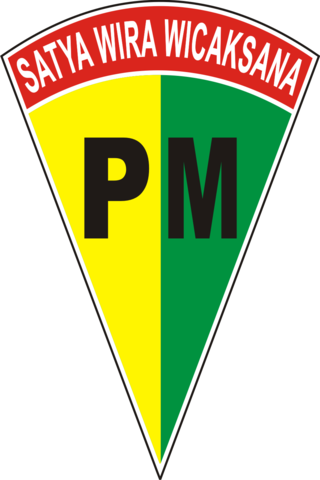
Puspomad or Army Military Police Center, which all of its personnel are part of the Military Police Corps (CPM) is one of the military general technical functions of the Indonesian Army which has the role for administering administrative assistance and as embodiment and guidance through the operation of Military Police functions. Its duties is basically to execute law enforcement towards the military which includes investigation activities and other policing duties within the scope of the army.


